|
Having trouble reading this email? Download the PDF.

Thematic Focus: Resource Efficiency
The end to cheap oil: a threat to food security and an incentive to reduce fossil fuels in agriculture
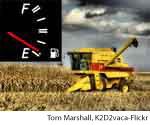
Why is this issue important?
Fossil fuels are essential for modern, mechanized agricultural production systems. Petroleum products are used directly to
power tractors, machinery and irrigation, and to transport, transform and package agricultural products. They are also used indirectly to
manufacture fertilizers and pesticides and prepare seeds. Thus, food production is energy intensive. For example, approximately 2 000
litres per year in oil equivalents are required to supply food for each American, which accounts for about 19 per cent of the total
energy used in the United States (Pimentel and others 2008).
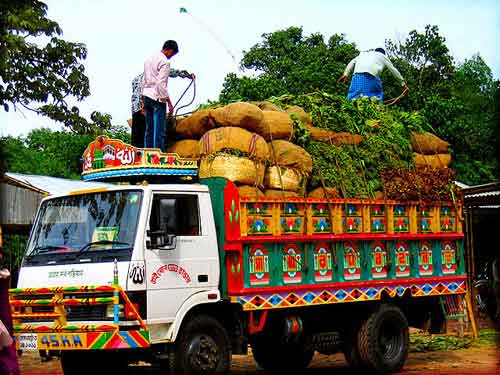
Truck being loaded to transport agricultural produce. Photo: Bengal Foam/Flickr
The industrialization of agriculture, known as the Green Revolution, occurred during the middle of the 20th century, as
farming became increasingly dependent on direct and indirect fossil fuel inputs (Wood and others 2010). Between 1945 and 1994, agricultural energy inputs
worldwide increased four-fold while crop yields increased three-fold. Since the early 1960s, the global growth in cereals depended almost entirely on
agricultural intensification, with little expansion in the area harvested (UNEP 2011) (Figure 1).
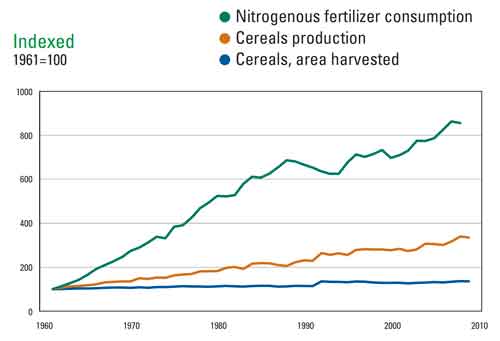
Figure 1: The global growth of fertilizer use and cereal production, 1960-2010. Source: UNEP 2011
Full Size Image
As machines replaced farm workers, the energy output-to-input ratio declined (Figure 2) (Pfeiffer 2003). In industrialised countries today, one food calorie requires expending
an average of between seven to ten calories of fossil energy (Dahlberg 2000).

Figure 2: Difference in energy input-to-output with the change in agricultural systems. Source: based on data from Pimentel 2009
Full Size Image
While food production—not to mention transportation and many other modern systems—has become ever more dependent on oil, world oil reserves have been dwindling. The amount of oil that
can be recovered cost effectively and the date at which oil production will begin to decrease is known as “peak oil”. Estimates of peak oil vary widely. In 2010, the International Energy Agency
(IEA) reported that conventional oil production reached a plateau in 2006 and started declining in 2009 (IEA 2010) (Figure 3).
Many experts believe that biofuel production is a solution; the rate of production is growing steeply worldwide and it is already partly replacing fossil-fuel use. The production of biofuels
instead of food crops in areas of Europe and in the United States is partly to blame for the 12.7 per cent decline in world cereal stocks between 2009 and 2011 (de Schutter 2011). The balance
between food and biofuel production is fragile, and in some regions, biofuel production could have detrimental impacts on the environment and human well-being. For example, energy crops
potentially have high water demands and so compete with food production (Amigun and others 2011). The production of unconventional oil, such as oil sands and shale gas, to mitigate the
decline in conventional oil production could have many environmental consequences, including climate change impacts, since their production requires higher water volumes and emits more
greenhouse gases than conventional oils (UNEP 2011b).
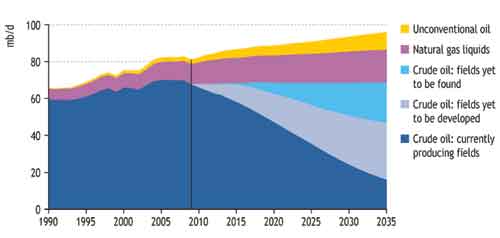
Figure 3: Conventional oil production reached a plateau in 2006. Source: IEA 2010
Full Size Image
What are the findings and implications?
The consequences of a potential increase in the price of oil as conventional oil production decreases would be manifold and likely serious. In addition to agriculture, many other
aspects of modern life are also highly dependent on inexpensive oil. Major price increases for transportation would occur, as 99 per cent of this sector depends on fossil fuels
(ITPOES 2008). Health impacts can also be expected, as oil is a primary raw material for many drugs and health services depend on cheap oil (Raffle 2010). National security also
depends heavily on oil, in terms of all types of military aircraft, land vehicles and ships requiring fuel (Gokay 2011).
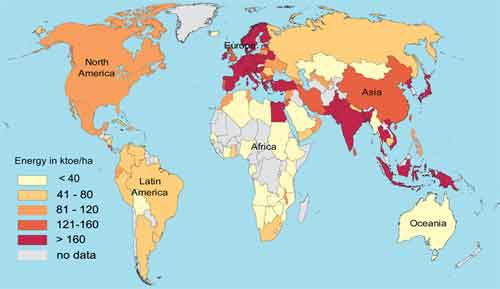
Figure 4: Energy used for agricultural production in kilo tonnes of oil equivalent per hectare
(ktoe/ha). Source: FAOSTAT 2011. Visualisation by UNEP GRID-Geneva
Full Size Image
One of the impacts of peak oil on the agriculture section would be a rise in fertilizer prices at a time when its use is increasing. By 2030, the FAO expects global fertilizer use to grow by 188 million tonnes (IAASTD 2009).
Peak oil could imply a reduction in the current heavy use of fossil energy inputs to agriculture (Figure 4), with many serious consequences. Already, the world is facing a
food crisis. In the next several decades, population growth, lifestyle modifications (including an increase in meat consumption), biofuel production, climate change and water pollution and
scarcity are all factors that will increase pressures on agricultural production (Arizpe and others 2011). The prices of basic food commodities (cereals, oils and fats, meat, sugar and dairy products)
have been rising in the last few years.
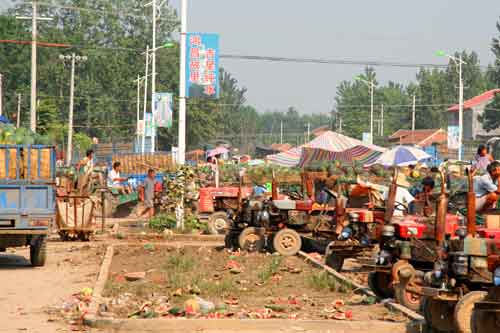
Tractors and trucks bringing water melons to the consumers. Photo: Adam Cohn/Flickr
Food prices increased since 2004 to an all-time high in February 2011 and since then have decreased slightly, but remain higher than ever before. This has contributed to the increase in the number of
undernourished people and to social unrest in several countries. Notably, the recent “Arab Spring” has been linked in part to increased food prices (Johnstone and Mazo 2011). Rising oil costs is not the
only factor influencing food prices, but since food production depends on oil, food prices are strongly linked to the price of oil (Figure 5) (OECD FAO 2010).
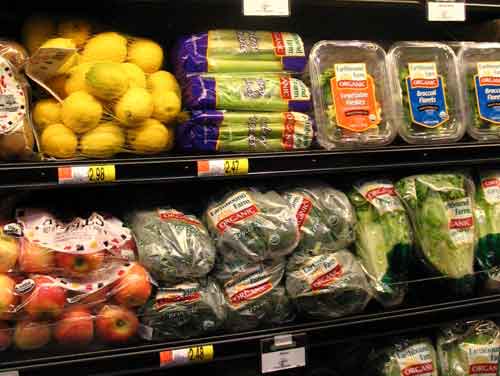
Food price on the rise. Photo: Walmart Stores/Flickr
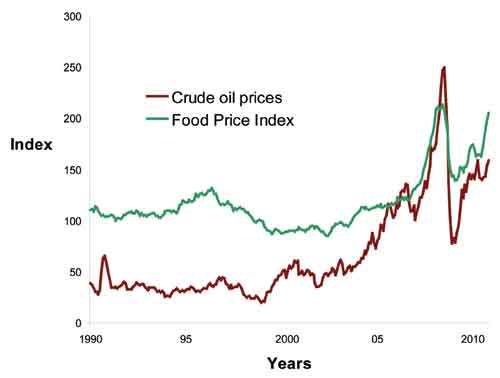
Full Size Image
Figure 5: The price of food is highly dependent on the price of oil. Source: FAO 2011; and Mundi Index 2011
Factors that influence fossil fuel use in agriculture
Agricultural methods: In general, the industrialisation of agriculture increased both fossil-fuel use and agricultural yields considerably; however there are many different types of agricultural
practices that require more or less fossil fuel, including organic farming, sustainable agriculture and intensive farming methods. Usually, the more technically advanced and mechanically
oriented an agricultural system, the more external energy is required.
Land availability: In areas with limited land, more fossil fuel is necessary to produce agricultural outputs using industrial agricultural techniques, which are more input-intensive.
In the world’s globalized economy and increasing international interdependence, no country is isolated from the loss of arable land to other uses (for example, urbanization) and its consequences.
Worldwide, there is currently 0.72 hectares per person of agricultural land. Based on the United Nation’s projected rise in population (UNPD 2011), this amount will drop to below 0.7 ha within the
next five years, without taking into account the degradation and loss of current agricultural land. If the high level of fossil fuel inputs used since the Green Revolution were to decrease, land
area would have to increase to maintain current yields (Goklany 2001). The amount of land available for agriculture is unlikely to increase, however, due to climate change (and associated sea-level
rise and other impacts), urbanization, land set aside to protect biodiversity, and unsustainable land management (Godfray and others 2010). Cutting trees to increase arable land area would increase
carbon emissions and lead to habitat and biodiversity loss and greater soil erosion (CGIAR 2011).
Different foods require different levels of energy inputs (Figure 5). Meat production needs particularly high energy inputs compared to cereals. Two and a half to ten times more energy is
required to produce the same amount of caloric energy and protein from livestock than can be gained directly from grains (Naylor 1996). The amount of energy to produce meat depends on the
production system. For example, industrialised systems that use feed produced from grain or soya, often imported from tropical countries, use more energy than systems where cattle are grass-fed.
Meat consumption per capita is unevenly distributed, but is much higher in developed countries (Figure 6). Global meat production and consumption is increasing and is expected to rise by 70 per cent
between 2000 and 2030 and by 120 per cent in the period between 2000 and 2050. This growth is a major cause of rising fertilizer use (IAASTD 2009).
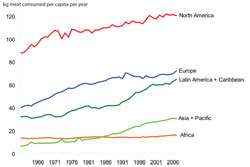
Trend in meat consumption per capita in different regions of the world. Source: UNEP Environmental Data Explorer n.d.
Full Size Image |
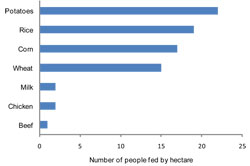
Number of people fed in a year per hectare, by different foods. Source: Horne and McDermott 2001
Full Size Image
|
|
Figure 6: Meat consumption per capita and number of people fed per year on different foods, by hectare
|
Soil degradation: Soil degradation occurs worldwide and is increasing (FAO 2008). The more degraded the soil, the greater the need for fertilizer. The use of inorganic fertilisers
(made from fossil fuels) hides decreases in soil fertility due to intensive agriculture practices (Mulvaney and others 2009). Energy is required to manufacture, package, transport and apply inorganic
fertilisers; thus, an increase in fossil fuel prices has an impact on fertilizers prices.
Transportation: Moving food from the producer to the consumer uses fossil energy. The extent and intensity of transportation has increased as agriculture has become more specialised and globalised,
food products are increasingly imported and exported and distances between producers and consumers have increased. By one estimate, food travels an average of 2,400 km in the United States before being
consumed (Pimentel and others 2008). Thus, agriculture’s dependence on fossil fuels has strengthened (Garnett 2003).
Transformation and packaging: In developed countries, 40 per cent of the fossil energy that supplies food is used to process, package, distribute and prepare the food (Pimentel 2009). Packaging is
necessary to ensure food security and protection and prevent waste. The type of packaging material can affect the amount of energy used (Ziesemer 2007), while recycling packaging and other management
approaches to waste packaging also involves energy, which needs to be considered (Canning and others 2010).
Options for the future
If the peak oil energy situation evolves, the agricultural production systems developed during the Green Revolution will have to be modified. There are several approaches to reducing the food system's
dependence on fossil fuels and they all require changes in agricultural practices, lifestyles and urban and rural development. A number of those suggested most often are listed in Box 1. Agronomic practices
like no-till, minimum tillage, crop diversification, crop rotation and integrated pest management, in combination with the strategic application of fertilizers and irrigation water, the use of low-impact
pesticides and the expansion of precision-farming procedures, are recommended as well-proved schemes that are more sustainable than those of intensive, high-input conventional farming both in terms of
energy use and other direct environmental impacts (Viglizzo 2012).
Box 1: Approaches for reducing fossil fuel use in agriculture
- Increase the efficiency of fossil fuel use in agriculture, by reducing the requirement of farm power per unit of land area, for example (eg,. smaller tractors,
less and lighter farm equipment, reduced use of machinery, less irrigation)
- Apply sustainable tillage practices that minimise soil erosion and compaction and also reduce the use of machinery and associated energy inputs.
- Adopt fertiliser and pesticide management schemes that reduce agrochemical use and the amount of indirect energy used, such as the methods employed by precision farming.
- Halt the degradation of arable land to conserve more land for agriculture, by stemming deforestation and overgrazing that erodes soils, for example.
- Increase the number of people working in agriculture and reduce farm sizes. It has been shown that for the same yields, smaller farms use less fuel than
big ones. This is often linked to the increased size of the labour force on small farms. A policy-making matrix integrating agricultural and conservation
elements can be used to encourage small-scale agroecological approaches, especially when they function within the payment-for-ecosystem-service framework (Perfecto and Vandermeer 2010).
Another suggestion is to support a global fund for micro-financing that would promote the development of diversified and resilient ecoagriculture and intercropping systems (UNEP-GRID 2009).
- Adopt environmental and social full-cost pricing of energy inputs to agriculture to discourage unsustainable production patterns.
- Reduce the transportation of agricultural products from farms to consumers by integrating agricultural production into human settlements and promoting locally grown and in-season products. Also, diminish the amount of refrigeration by
encouraging consumers to buy smaller quantities of in-season fresh produce more frequently. Community Supported Agriculture (CSA), a partnership between a local organic farmer and his clients involving a subscription to weekly baskets of produce,
achieves these aims (Van En 1995), as do garden allotments and local produce markets in cities.
- Increase the production of animal feed on the farm or in its vicinity.
- Develop sustainable energy systems to replace fossil energy sources. For example, irrigation and some farm machinery could use solar or wind power instead of fossil fuels.
- Reduce the amount of meat consumed worldwide, since vegetarian options require far less energy to produce than meat.
- Introduce sustainable practices for large-scale commercial livestock production. An example is by increasing the growth rate in beef cattle, resulting in significant declines in
land, water, fossil fuels and feed consumption, as well as less waste outputs (manure and GHG).
- Develop biofuel production from waste, by-products or feedstock instead of using food crops for biofuels (UNEP-GRID 2009).
- Implement a certification scheme for sustainable production and good practices to reduce energy use.
- Introduce a combination of regulatory instruments, incentives and public-private initiatives that would help to reduce fossil fuel inputs in agriculture (Alemany and Lanzilotta 2011).
|
Conclusions
|
|
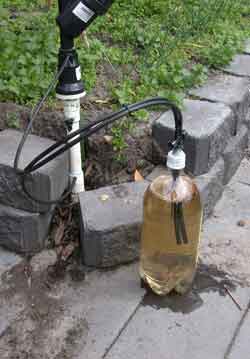
Injecting liquid fertilizer into a drip irrigation mainline Photo: graibeard/Flickr
|
Current levels of agricultural production depend on cheap oil, but this dependence needs to decline to avoid food shortages and higher prices in the future. Supplying adequate food and water are
global priorities. Sustainable food production requires sustainable energy resources. There are already examples of efforts to reduce the environmental impacts of farming that have successfully reduced
fossil fuel use. For example, over the last 50 years, Argentina has adopted low-input/low-impact schemes in its farming sector, which resulted in lower energy consumption (as well as soil erosion and
other impacts) than some European countries, China, Japan, New Zealand and the United States (Viglizzo and others 2011). In another example, various Brazilian organizations unified criteria and efforts
to develop the Integrated Crop–Livestock-Zero-Tillage System (ICLZT). Integrating crop rotation, livestock production and zero-tillage in the Brazilian Cerrado resulted in sustainable grain and meat
production on the same lands using less fertilizer and herbicides and without requiring further deforestation (in addition to less soil erosion, improved soil biological activity and nutrient recycling
and lower greenhouse gas emissions) (Landers 2007). It is urgent to replicate actions such as these, since it will take time to develop and implement energy savings in the farming sector on a scale
that will have a global impact.
Acknowledgment
Written by: Ruth Hardinga, Pascal Peduzzib
Production and Outreach Team: Arshia Chanderc, Bruce Pengrac, Erick Litswad, Kim Giesec,
Michelle Anthonyc, Reza Hussainc, Theuri Mwangid
Special thanks to Graciela Metternichte and Jane Barra for editorial review
( a Consultant, b UNEP GRID Geneva, c UNEP GRID Sioux Falls, d UNEP Nairobi, e UNEP ROLAC)
References
Alemany, C. and Lanzilotta, B. (2011). Resource Efficiency: Economics and
Outlook for Latin America, Case Studies: Mercorsur, Chile and Mexico, Executive Summary. Panama City: United Nations Environment
Programme (UNEP), Regional Office for Latin America and the Caribbean. Accessed online on April 15, 2012 at
http://www.pnuma.org/reeo/Documentos/Web_INGLES_Executive%20Summary_29_08_2011_.pdf
Amigun, B., Musango, J., and Stafford, W. (2011). Biofuels and sustainability. Africa Renewable and Sustainable Energy Reviews, 15:1360-1372
Arizpe. N., Giampietro, M. and Ramos-Martin, J. (2011). 2011 Food security and fossil energy dependence: an international comparison of
the use of fossil energy in agriculture (1991-2003). Critical Reviews in Plant Sciences, 39: 45-63
Canning, P., Charles A., Huang S., Polenske, K. and Waters, A. (2010). Energy Use in the U.S. Food System. USDA Economic Research Report, Number 94
CGIAR (2011). Measuring the Environmental Impacts of Agricultural Research: Theory and Applications to CGIAR Research. Consultative Group on International Agricultural Research.
Accessed online on March 28, 2012 at http://www.sciencecouncil.cgiar.org/fileadmin/templates/ispc/documents/Publications/EIAStudy2011James.pdf#page=63
Dahlberg, K. (2000). Agriculture, food systems, energy and global change. Science 290:1300
de Schutter, O. (2011).Vers une nouvelle crise alimentaire. Les Echos, 20845: 9. Accessed online on September 15, 2011 at
http://www.commercialpressuresonland.org/press/olivier-de-schutter- per centC2 per centABvers-une-nouvelle-crise-alimentaire per centC2 per centBB
FAO (2011). Food Price Index World Food Situation. Accessed online on March 4, 2012 at http://www.fao.org/worldfoodsituation/FoodPricesIndex/en/
FAO (2008). Land degradation on the rise. FAO Newsroom . Accessed online on August 24, 2011 at http://www.fao.org/newsroom/en/news/2008/1000874/index.html
FAOSTAT (2011). Food and Agriculture Organization of the United Nations. Accessed online on March 28, 2012 at http://faostat.fao.org/
Garnett, T. (2003). Wise moves: exploring the relationship between food, transport and CO2. Transport 2000 Trust. www.transport2000.org.uk
Godfray, H., Beddington, J., Crute, I., Haddad, L., Lawrence, D., Muir, J., Pretty, J., Robinson, S., Thomas, S. and Toulmin, C. (2010). Food security: the challenge of feeding 9 billion people. Science, 327: 812-818
Gokay, B. (2011). Past peak oil – life after cheap fossil fuel. Public Service Europe. Accessed online on March 28, 2012 at http://www.publicserviceeurope.com/article/705/past-peak-oil-life-after-cheap-fossil-fuels
Goklany, I.M. (2001). Modern agriculture: the pros and cons of modern farming: boon or bane for the environment? PERC Reports, 19: 12-14
Horne, J. and McDermott, M. (2001). The next green revolution: essential steps to a healthy, sustainable agriculture. New York: Food Products Press
IAASTD (2009). Agriculture at a Crossroads: Global Report. International Assessment of Agricultural Knowledge, Science and Technology for Development. Accessed online on April 12, 2012 at http://www.agassessment.org/
IEA (2010).World Energy Outlook 2010.Paris: International Energy Agency
ITPOES (2008). The oil crunch—securing the UK’s energy future. Report from 29 October 2008. UK Industry Task Force on Peak Oil and
Energy Security. Accessed online on March 28, 2012 at http://peakoil.solarcentury.com/wp-content/uploads/2008/10/oil-report-final.pdf
Johnstone, S. and Mazo, J. (2011). Global warming and the Arab Spring. Survival, 53:11-17
Landers J.N. (2007). Tropical crop–livestock systems in conservation agriculture: The Brazilian experience. Integrated Crop Management Vol. 5. Rome: Food and Agriculture Organisation of the United Nations
Mulvaney, R., Khan, S. and Ellsworth, T. (2009). Synthetic nitrogen fertilizers deplete soil nitrogen: a global dilemma for sustainable cereal production. Journal of Environmental Quality, 38: 2295–2314
Mundi Index (2011). Oil Price Index. Accessed online on March 4, 2012 at http://www.indexmundi.com/commodities/?commodity=petroleum-price-indexandmonths=300
Naylor, R. (1996). Energy and resource constraints on intensive agricultural production Annual Review of Energy and the Environment, 21: 99-123
OECD/FAO (2010). OECD-FAO Agricultural Outlook 2010-2019.Paris and Rome: Organisation for Economic Co-operation and Development and the Food and Agriculture Organization of the United Nations
Perfecto, I. and Vandermeer, J. (2010). The agroecological matrix as alternative to the landsparing/agriculture intensification model. PNAS 107: 5786-5791
Pfeiffer, D. (2003). Eating Fossil Fuels. Sherman Oaks, CA: From The Wilderness Publications. Accessed online on March 28, 2012 at www.fromthewilderness.com/free/ww3/100303_eating_oil.html
Pimentel, D. (2009). Energy inputs in food crop production in developing and developed nations. Energies, 2: 1-24
Pimentel, D., Williamson, S., Alexander, C., Gonzalez-Pagan, O., Kontak, C. and. Mulkey, S. (2008). Reducing energy inputs in the US food system Human Ecology, 36: 459–471
Raffle, A. (2010). Oil, health, and health care. British Medical Journal, 341: Editorial
UNEP Environmental Data Explorer (no date). Accessed online on March 28, 2012 at http://geodata.grid.unep.ch/
UNEP (2011). Decoupling natural resource use and environmental impacts from economic growth, A Report of the Working Group on Decoupling to the International Resource Panel. Fischer-Kowalski, M.,
Swilling, M.,von Weizsäcker, E.U., Ren, Y., Moriguchi, Y., Crane, W., Krausmann, F., Eisenmenger, N., Giljum, S., Hennicke,P., Romero Lankao, P., Siriban Manalang, A.
UNEP (2011b). Athabasca oil sands require massive investments and energy and produce massive amounts of oil and CO2- Alberta, Canada. Global Environmental Alert Service (GEAS). Accessed online on
March 28, 2012 at http://na.unep.net/geas/
UNEP-GRID (2009). The Environmental Food Crisis: The Environment's Role in Averting Future Food Crises. EarthPrint
UNPD (2011). World Population Prospects, 2010 Revision. United Nations Population Division. Accessed online on April 24, 2012
at http://esa.un.org/unpd/wpp/Analytical-Figures/htm/fig_1.htm
Van En, R. (1995). Eating for your community: A report from the founder of community supported agriculture. In Context, 42, Fall.
Accessed online on April 15, 2012 at http://www.context.org/ICLIB/IC42/VanEn.htm
Viglizzo, E.F., Frank, F.C, . Carreño, L.V., Jobbágy, E.G., Pereyra, H.,Clatt, J.,Pincén, D. and Ricard, M.F. (2011). Ecological and environmental footprint of 50
years of agricultural expansion in Argentina. Global Change Biology, 17:959-973
Viglizzo, E. (2012). Personal Communication
Woods, J., Williams, A., Hughes, J., Black, M. and Murphy, R. (2010). Energy and the food system. Philosophical Transactions of the Royal Society B, 365:2991-3006
Ziesemer, J. (2007). Energy Use in Organic Food Systems. Natural Resources Management and Environment Department, Food and Agriculture Organization of the United Nations
If you no longer wish to receive this bulletin you can unsubscribe anytime.
Information is regularly scanned, screened, filtered, carefully edited, and published for educational purposes. UNEP does not accept any liability
or responsibility for the accuracy, completeness, or any other quality of information and data published or linked to the site. Please read our
privacy policy and
disclaimer for further information.
|

















